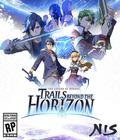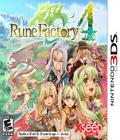Rune Factory began as a spin-off of the Harvest Moon franchise but has since taken off. At its core, it's still very much a Harvest Moon game and shares many similarities to that long-running franchise. The big difference is Rune Factory has combat. Between bouts of farming cabbage and milking cows, you're sent out to defeat monsters. Rune Factory is a family-friendly game, so every sword swipe sends the monsters home, rather than slaying them, and treasure chests can be full of boiled eggs and plant seeds or gold and ancient swords. Trying to mix the two play styles has led to some quirky titles. Rune Factory 4 is probably the least original of the lot, but it is also the most polished and accessible to date, and that counts for a lot.
In RF4, players take control of either Lest (a boy) or Frey (a girl), a young person on the way to the city of Selphia. Their airship is ambushed by bandits who knock the protagonist on the head and send them off the side of the vessel. Fortunately, this occurs above the home of Ventuswill, the dragon who guards Selphia. The hero wakes up with amnesia and this causes Ventuswill and the townspeople to assume that he or she must be the royal heir who was supposed to take over the town. As the ruler of the town, you must do odd jobs and farm in addition to issuing royal decrees and living in a castle. Even when the actual prince shows up, he cedes the job to your hero since you've been doing such a great job. There's a deeper plot involving the dragons, the gradual decline of magical "runeys," and your character's true identity, but it is mostly done in a lighthearted way. It's a fun story with a few dark moments, and things almost always turn out for the best.
Selphia is a thriving city, and there is a ton to do. You begin with a small farm behind the castle, and you can use it to begin a healthy and profitable farming business. As the game advances, you can get additional farms or expand the size of your original farm, get animal-like monsters to give you eggs, milk and honey, or use those animals as farm workers to automate some processes. It's very similar to Rune Factory 3, but it's more polished. Soil quality and fertilizer are a major part of the game, but they're more for die-hard fans than casual players. Everyday players can farm to their heart's content without worrying about soil quality. Serious players will rotate crops to avoid damaging the soil or treat their crops with expensive fertilizer and growth potions to get the highest possible yield. It's nice that both sets of players can play the same game without any issues.
You can also craft by obtaining a forge, a kitchen set, a crafting table, and a chemistry lab, which allow you to create items. More complex items require you to level up skills by creating weaker items first; otherwise, they take an exorbitant amount of Rune Points (stamina) to make. Once you've made items, you can start improving them. Using higher-quality material gives you a higher-quality base item, which has a higher resale value. You can also use materials to upgrade items with new attributes, higher stats, or other cool features. You can spend hours crafting the perfect set of equipment for your character, or you can turn it into a profitable business. Much of my early game money came from buying cheap wool supplies from a shopkeep and converting it into far more profitable yarn.
As always, the townspeople are a big part of the game. You can befriend almost everyone, and that unlocks abilities and side-quests. You can even have your character date and eventually marry one of the townsfolk in true Harvest Moon style. The translation is solid and imbues (almost) every character with a likeable personality. My favorite character was Arthur, the amusingly nerdy prince who would rather spend his days working on the local harvest report than attending to his royal duties.
The biggest new feature in RF4 involves royal duties. For just about every little thing you do, you unlock prince/princess points. If you do big things for townspeople, you'll get a bunch. If you take down monsters, you'll get a few for each defeated monster. These points are a measure of how much the townspeople will tolerate you declaring things on a whim. The more points you have, the more things you can do. You can get licenses to cook, forge, run a shop or drive an airship. You can order shops to sell certain items, that a festival be held, or that your backpack be upgraded. The more significant the order, the more PP it costs. It's a good system to encourage you to vary your mechanics because keeping everyone happy involves not focusing on one thing. You can still do that if you want, but it'll take longer to build up PP.
Part of what makes Rune Factory fun is that you're not pigeonholed into doing one thing. You can spend a month running your personal shop or make a giant, sprawling farm and carefully balance the fertilizer levels and nutrients to get the best possible crops. You can become a blacksmith and make your money forging weapons and armor. You could adventure all the time and not worry about making stuff. You'll progress faster if you mix things up, but I never felt like I was being held back when I let medicine crafting fall by the wayside. It also wasn't difficult to get back into it once I picked it up again.
RF4 has a lot of adventures. The game is packed with dungeons, both plot-related and optional. They're not overly complex but tend to have enough depth that it might take multiple days to complete one, especially later in the game. Combat uses a simple isometric style similar to the old-school Zelda games, and it largely involves swinging your weapon at enemies until they fall down. You can use anything from short-range daggers to massive broadswords and axes, each with varying speed and power. As you use weapons, you unlock the ability to charge them up for extra damage or unleash an ultimate attack that drains some of your RP but hits hard. You also unlock special rune skills that can be anything from fireballs to powerful swings of your sword but require a chunk of RP. Combat is fun, especially when you're trying to clear large rooms of enemies without getting hit, but it falls into some rote patterns after a while. There's only so much variety available with the combat system, and you'll probably fall back on the same few powers.
You can also invite your townsfolk friends to adventure in the dungeons with you, but you'll need to equip them, and that can be costly. On the other hand, you can also bring along any monsters you've tamed to work on your farm. These monsters are weaker in the long run but can survive well on their own. It's also hilarious to see a pair of chickens brutalizing their way through a goblin encampment. You even can gain special buff songs that power up your allies or convince them to attack certain enemies, if you'd prefer to not do the fighting.
The fun thing about Rune Factory is how these two elements combine. All the crafting, farming, making friends — pretty much everything you do in the game — contribute to your combat strength. There are stat levels for everything from swordplay to bathing to sleeping. The more you do, the higher your stats are. If you spend a lot of time crafting, befriending people, and growing crops, you'll get stronger as surely as if you punched enemies to grind levels. On the other hand, going into dungeons and fighting enemies allows you to do more in the social and crafting aspects. You unlock new characters for the town, new materials to use in crafting, and plot sequences that offer new opportunities or new places to farm. You're never stuck doing one thing for too long.
RF4 isn't the best-looking title on the 3DS, unfortunately. The graphics are fine, but they're not a huge improvement over the original DS titles and can be a little muddy in spots. The character artwork retains the modern Harvest Moon style of "everyone looks roughly 12 years old," which leads to some adorable art design but feels weird when marriage and romance come into play. The 3-D effect in this game is among the worst I've seen on the 3DS. It's muddy and doesn't add any sense of depth. I strongly advise playing without the 3-D because it only detracts from the experience. The soundtrack is good but not very memorable.
Rune Factory 4 is probably the most polished and well-crafted Rune Factory to date. It doesn't change the gameplay much, and that's sometimes to its detriment, but that also makes it a very accessible and enjoyable title. It's fun to play, regardless of whether you're crafting swords, running a high-yield farm, or battling monsters in a dungeon. There's always something to do, and it's always fun to do it. It has flaws, but none really take away from the overall experience, and there really isn't another game on the 3DS quite like it. If you're looking for an RPG where saving the world comes second to growing turnips, Rune Factory 4 is the game for you.
Score: 8.0/10
More articles about Rune Factory 4 Special











 Rune Factory 4 combines the farming elements the series is renowned for, with classic action-JRPG elements in a stunning fantasy setting.
Rune Factory 4 combines the farming elements the series is renowned for, with classic action-JRPG elements in a stunning fantasy setting.












